Grimsby and Immingham Electric Railway
(Grimsby District Electric Railway)
History
The Grimsby and Immingham Electric Railway was owned and operated by the Great Central Railway Company, and was primarily built to service the large, deep-water dock complex at Immingham.
In order to enable construction of the dock, and afterwards transport the workforce needed to operate it, the GCR obtained powers — under the Grimsby District Light Railway Order (granted on the 15th January 1906) — to build a standard-gauge light railway between Immingham Docks and Grimsby, circa 7 miles to the east. The line was to divide at Pyewipe, just to the west of Grimsby, the northern arm (a railway) joining up with the GCR's existing Pyewipe Chemical Works branch line, and the southern arm (most of which was a street tramway) running through the Alexandra Dock Estate to join up with the Great Grimsby Street Tramways Company's system in Victoria Street, across the River Fresney. The G&IER and the GGST were not, however, destined to be connected, the hand-cracked swing bridge over the Alexandra Dock (River Fresney) not being replaced until 1928, by which time Grimsby Corporation (owners of the town's tramway from 1925 onwards) had embarked on a journey that would see its trams replaced by trolleybuses.
A contractor's railway line was built between the dock site and Grimsby (Western Marshes, referred to as Pyewipe) in 1906, over which the GCR introduced passenger-carrying services — using steam rail motors — from the 3rd January 1910. It had originally been intended that the street tramway through Alexandra Dock would be operated as a shuttle service, passengers switching to the steam services at Pyewipe; in 1909 however, the GCR reconsidered this, instead electing to build an electric tramway alongside the railway, but separate from it, and all the way to Immingham. The street tramway section was completed in 1910, with the remainder (a high-speed interurban line running along a private right of way) being finished in the summer of 1911; however, as the docks were not yet finished, the tramway remained for the time being, unopened.
Services over the new overhead electric tramway commenced on the 15th May 1912, passenger services on the adjacent steam railway having been withdrawn the day before. The line ran from a terminus outside Immingham Docks — called Immingham Town — southeastwards and parallel to the Humber to Pyewipe, where it turned southwards and eastwards over Cleveland Bridge to a terminus in Corporation Street just short of the swing bridge.
An extension into Immingham Docks was opened on the 17th November 1913; this ran northwards from Immingham Town, over the steam railway then northwestwards into the dock itself. Although tracks were laid westwards from Immingham Town towards Immingham Village in 1914/15 (approximately 0.5 miles), this was a legal obligation which the company could not evade; it was probably included in the original agreement with the landowner as part of a plan to extend the tramway towards Habrough, though by 1914, and possibly long before, the GCR had lost interest. Other than an empty tramcar once a month (another legal obligation), it was never used by passenger-carrying services. These extensions took the tramway to its final size of 7.75 miles.
The company seems to have underestimated the number of tramcars it would need, which suggests that loadings were heavy; it quickly ordered eight more, four arriving in the autumn of 1913 and the remainder in 1915. Like most systems, the tramway suffered from the exigencies of the Great War, namely, shortages of men (and skills) and difficulties sourcing spares, but was probably nowhere near as badly impacted as the majority of British street tramways, given that its infrastructure was new, and also, that it did not have to cope with the effects of heavy war-time road traffic damaging its tracks.
The GCR was amalgamated with several other railway companies on the 1st January 1923 to form the London and North Eastern Railway Company. The GCR it should be noted, always referred to the tramway as the Grimsby District Electric Railway, the more familiar Grimsby and Immingham Electric Railway being introduced by the LNER.
Given that there was no direct road from Grimsby to Immingham Docks, the tramway was to a large extent shielded from the unfettered motorbus competition that impacted most tramways during the 1920s. The only competition in this respect came from Grimsby Corporation in 1928, though this was confined to the short street tramway section; the LNER responded by introducing a shuttle service between Corporation Street and Stortford Street (just short of Cleveland Bridge), but withdrew it two years later when it became clear that there was little call for a service along the road.
In the 1930s, various attempts were made to initiate the building of a direct road route to Immingham, and whilst these would not come to fruition during the tramway's lifetime, they undoubtedly cast a shadow over the G&IER, the LNER being reluctant to invest in modernising the tramway with the ever-present possibility of a direct road that would have abstracted a significant number of passengers. Other than this, the inter-war years were relatively uneventful as far as the tramway was concerned, save for a decision to withdraw three of its four lower-capacity tramcars, a decision that the company would eventually come to regret.
During the Second World War, Grimsby Corporation began to develop large areas of land between the G&IER and the Humber shoreline, major industries being attracted to the area by its proximity to the deep-water dock. As a result, passenger numbers increased to the point where the tramway could barely cope, even though it was operating, as it always had done, around the clock (24 hours a day).
The LNER was nationalised on the 1st January 1948, responsibility for the tramway passing to the British Transport Commission, whose railway operating arm, the Railway Executive, was branded as British Railways. The G&IER was now operated by BR's Eastern Region, which inherited a tramway that had been kept in a reasonable state of repair, but which was in urgent need of modernisation. By this time, the track along the street tramway section was in appalling condition, BR(E)'s management viewing this as an opportunity to close the section completely and replace it with corporation motorbuses. This would not only allow BR(E) to divest itself of a liability, but also to retain the passengers, who were anyway all travelling through to Immingham; unfortunately for BR(E), agreement could not be reached with the corporation, so the entire section had to be relaid.
The line's capacity issues were temporarily addressed in June 1948 by the purchase of three ex-Newcastle Corporation Tramways tramcars, and again more permanently in August 1951, through the acquisition of 19 ex-Gateshead and District Tramways vehicles. At the same time, the original G&IER tramcars were rebuilt, giving the tramway a more than adequate number of reliable cars.
Passenger numbers continued to rise in the early 1950s, which resulted in BR(E) introducing a railway service between Immingham and Cleethorpes via Habrough and Grimsby; although the route was circuitous, it carried significant numbers of workmen, and undoubtedly took pressure off the tramway. Despite the healthy passenger numbers, the line was making heavy losses, due in part to manpower costs — for example, up to seven tramcars ran in convoy during peak hours, all of which required crews, unlike a train of seven carriages — but also to the fact that around a third of the passengers travelled for free, including large numbers of men working at BR(E)'s Immingham Motive Power Depot.
Under the Light Railway Order, Grimsby Corporation was entitled to purchase the section of tramway within its municipal boundary after 21 years had expired, and thereafter every 7 years; when one of these cycles fell due in 1955, the corporation suddenly decided that it would trigger the clause and purchase the tramway, even though it would have been compelled to lease it back to BR(E). The latter however, saw in this another opportunity to divest itself of the street tramway section, offering it to the corporation for free, the corporation accepting on the 20th June 1955. It was, however, to be 12 months before the section was closed — due to concerted union opposition — the last tram running over it on the 30th June 1956, GCT motorbuses replacing them the following day. BR(E) seems to have had the best of the deal, as in the absence of a direct road, passenger numbers remained largely unchanged, the captive clientele still having to take the tram from the new terminus at Cleveland Bridge.
During the remainder of the decade, and despite carrying circa one million passengers a year, the tramway was still losing money, BR(E) making regular appeals — all in vain — for the various industries and companies which benefitted from the line to make a financial contribution, i.e., to subsidise the service. Eventually, in early 1958, BR(E) gave notice that it would close the tramway, a move that resulted in a formal meeting of the Transport Users Consultative Committee for the East Midlands — on the 24th April 1959 — at which a large number of objections were heard. The outcome was an agreement to reduce the tram services to peak times, with Grimsby-Cleethorpes Joint Transport Committee and the Lincolnshire Road Car Company providing bus services at other times, though via a circuitous, 11-mile route.
Despite the roundabout journey, the buses carried more and more passengers, a situation which could only end one way, with BR once again applying to close the line on the 29th December 1960, this time successfully.
The last tram ran on the 1st July 1961.
Uniforms
Only a single photograph of a tramcar crew appears to have survived from GCR days (1912 to 1922). This shows a motorman and a conductor, both of whom are wearing double-breasted lancer-style tunics with five pairs of nickel buttons (narrowing from top to bottom, and presumably of the standard GCR block initials pattern — see link) and stand-up collars. The collars do not appear to have borne any insignia, though it would be unwise to place too much faith in a single image taken around the time of the tramway's opening. Photographs of GCR railway staff show that many were issued with one-piece 'GCR' block-capital badges, which were usually affixed to the bearer's jacket lapels, and it is possible that these badges may at some point have been used on the collars of G&IER uniforms. The soft-topped peaked caps bore system initials — 'G C R' — in individual block capitals, probably in nickel to match the buttons.
Photographic evidence from LNER days (1923-1947) is likewise extremely thin on the ground, the only reasonable image I am aware of being taken in 1946. This shows two men in long coats, one possibly an inspector, and the other, possibly a motorman; although the latter's greatcoat inevitably obscures his jacket underneath, it is unbuttoned, revealing a shirt and tie and a jacket button, enough to suggest that the jacket was in fact single-breasted with lapels. It seems reasonably likely that the jacket would have carried an embroidered cloth LNER 'eye' badge on the bearer's right-hand lapel, as this was fairly standard practice following the introduction of the 'eye' logo in 1937. What badges were worn prior to this must await the discovery of further photographic evidence. The LNER changed the style of button several times between 1923 and nationalisation, and it is likely that tramwaymen's jackets bore at least four different types of button over this 24-year period (see link).
The motorman in the photograph is also wearing a soft-topped cap clearly bearing a cap badge of some description, though unfortunately, the image is too poor to make a positive identification.
During the BR era (1948-1961), motormen and conductors seem to have worn double-breasted jackets with three pairs of buttons (probably brass and of the BR wheel pattern — see link) and lapels; the jackets did not bear any insignia. Caps were now of the tensioned-crown type, though some staff continued to wear soft-topped peaked caps; both types carried brass 'totem-style' cap badges bearing 'BRITISH RAILWAYS', inlaid with the Oxford Blue enamel that signified BR's Eastern Region. In 1956, British Railways replaced its 'totem-style' brass cap badges with a new 'fishtail' design, still bearing 'BRITISH RAILWAYS', and inlaid with the Oxford Blue enamel, but in gilt rather than brass. Around the same time, an additional cap badge was introduced comprising a demi-lion holding a wheel, emerging from a crown; this was worn above the enamel badge. Unfortunately, only a single staff photograph has so far been discovered from this period, in which a crew member appears to be wearing the aforementioned lion badge, but with a 'totem-style' badge beneath it rather than the 'fishtail' design. Although it seems likely that tramcar crews were indeed issued with 'fishtail' cap badges, there is currently no photographic evidence to confirm this.
Unfortunately, no photographs of GCR senior tramway staff (inspectors) are known to have survived, so it is unclear what uniforms were worn, or indeed whether the GCR even used inspectors on the tramway. Information about the GCR's successor — the LNER — is only marginally better, with just the aforementioned 1946 photograph to go on, and this is hardly definitive. Assuming the individual in the photograph is indeed an inspector, all that can be gleaned is that he was issued with a tensioned-crown peaked cap that does not appear to have borne a reflective cap badge. Various LNER embroidered cloth 'INSPECTOR' badges have survived, and if the LNER did indeed make use of this grade on the tramway, then there is every possibility that these men would have worn jackets bearing these badges (see below for two examples).
There is currently no information available to indicate which senior staff grades were employed on the tramway during the British Railways era; candidates include 'Inspector', 'Ticket Inspector', 'Foreman', and even 'Station Master'. To simplify matters, the following description of senior staff uniforms and insignia is confined to the grade 'Inspector'. BR inspectors initially wore double-breasted suit-style jackets with three pairs of plain buttons and lapels; the jackets were devoid of insignia. Up until 1950, the tensioned-crown caps carried hat bands that probably bore the grade — 'INSPECTOR'— in embroidered letters, though this is far from certain. From 1950, a new brass cap badge was issued; this comprised a stylised lion over a wheel, with a central bar bearing the grade — 'INSPECTOR' — inlaid with Oxford Blue enamel. This type of cap badge was possibly superseded — from around 1956 — by a dark blue oval cloth cap badge bearing a gilt demi-lion holding a wheel, emerging from a crown, surrounded by gold wire oak leaves; this would have been worn high on the cap, above a hat band with the grade embroidered upon it. Although the gold-wire leaves were replaced by a one-piece gilt metal version around 1960, this may well have been after the closure of the tramway. As yet, there is no photographic evidence that would confirm whether this type of cloth badge was worn by senior staff working on the tramway.
BR tramwaymen were also issued with double-breasted greatcoats with three pairs of buttons, three waist/hip-level pockets, and lapels; these garment appear not to have carried any insignia.
Women appear not to have been employed during the Great War to replace tramwaymen lost to the armed services, boys as young as 15 years being taken on instead. Women were certainly employed as conductresses during the Second World War, the last apparently leaving at the end of 1946 or early in 1947. Once again, the photographic evidence is sparse indeed, just a single photograph taken in late 1946, so what follows can only be viewed as tentative. The photograph shows four ladies, two of whom are wearing single-breasted jackets with five buttons (presumably of the war-time black horn, script 'NE' pattern) and lapels, along with matching trousers. It is probable that the bearer's right-hand lapels bore cloth LNER 'eye' badges, though these cannot be made out on the photograph, which is not sufficiently sharp or clear. The other two ladies are wearing long, wrap-around, light-coloured dustcoats, along with skirts, suggesting that they may be cleaners; the dustcoats had a single, waist-level pocket, and appear to have been devoid of insignia. All the ladies in the photograph are wearing soft-topped caps; those wearing the dustcoats clearly have 'N E' block letters on their caps, whereas the uniformed ladies have a badge of unknown pattern.
Further reading
For a history of the Grimsby and Immingham Electric Railway, see: 'The Tramways of Grimsby, Immingham and Cleethorpes' by J H Price; Light Rail Transit Association (1991).
Images
Motormen and conductors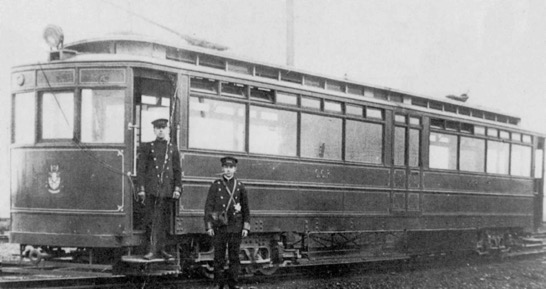
A motorman and a conductor with one of the original large-capacity single-deck tramcars bought for the opening — photo undated, though given the good condition of the vehicle, probably taken in 1912 or 1913. Source unknown.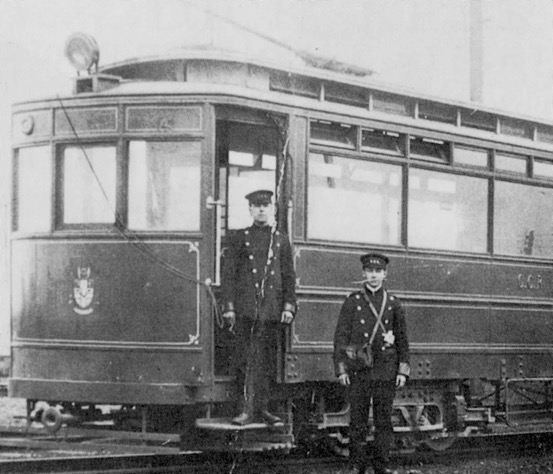
An enlargement of the above photograph showing the tramcar crew, both of them in typical tramway, rather than railway, uniforms. The collars do not appear to bear any badges, whilst the caps, which are soft-topped, bear individual company initials, 'G C R'.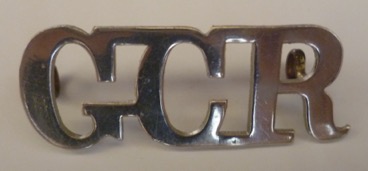
GCR block letters collar badge — nickel. Tramcar staff may possibly have worn this badge at some stage, though confirmatory photographic evidence is currently lacking. Author's Collection.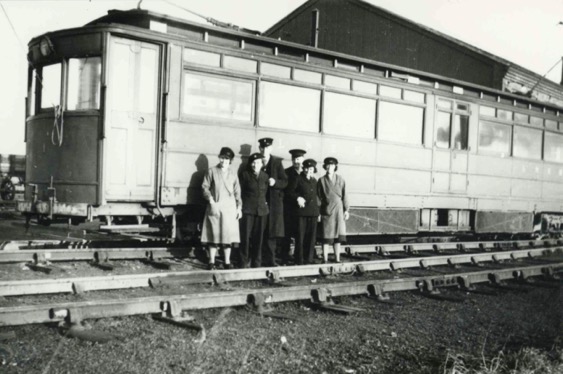
A group of staff with one of the GCR long, single-deck tramcars on the 30th December 1946, presumably at Pyewipe. Photo by R B Parr, courtesy of the National Tramway Museum. 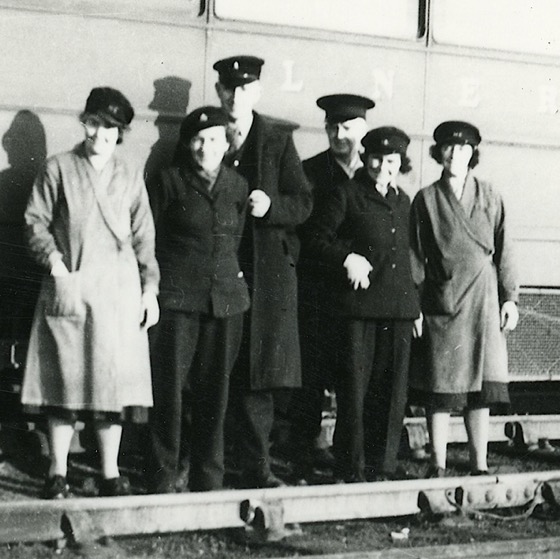
An enlargement of the above photograph showing the staff, two men and four ladies. Whilst at least two of the ladies are wearing war-time 'N E' initials cap badges, it is less clear what the men are wearing. The man at the back right may well be an inspector.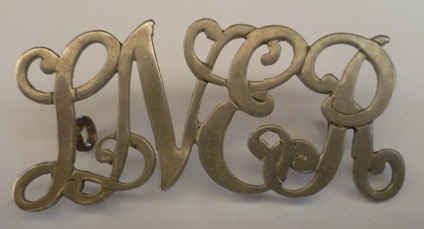
LNER script initials cap badge — nickel. Tramcar staff may possibly have worn this badge at some stage, though confirmatory photographic evidence is currently lacking. Author's Collection.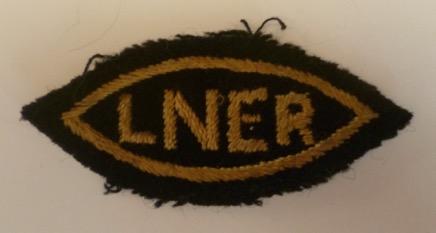
LNER 'eye' lapel badge — yellow embroidery on dark blue cloth. Tramcar staff may possibly have worn this badge on the right-hand lapel of their jackets at some stage, though confirmatory photographic evidence is currently lacking. Author's Collection.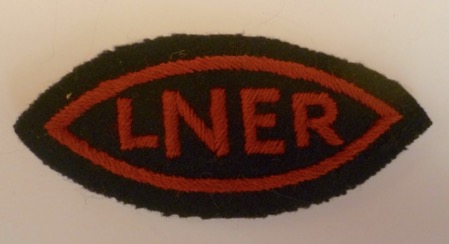
LNER 'eye' cap badge — red embroidery on dark blue cloth. Tramcar staff may possibly have worn this badge at some stage, though confirmatory photographic evidence is currently lacking. Author's Collection.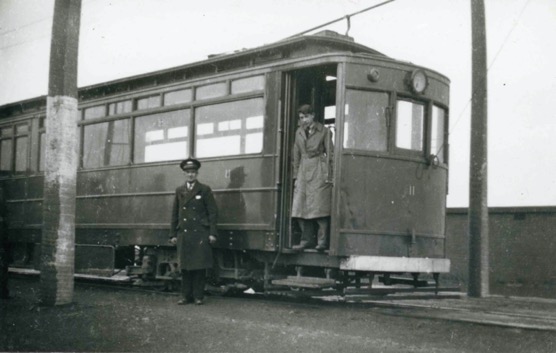
A motorman poses for the cameraman with Tramcar No 11 on Easter Monday (6th April) 1953. Photo courtesy of the National Tramway Museum. 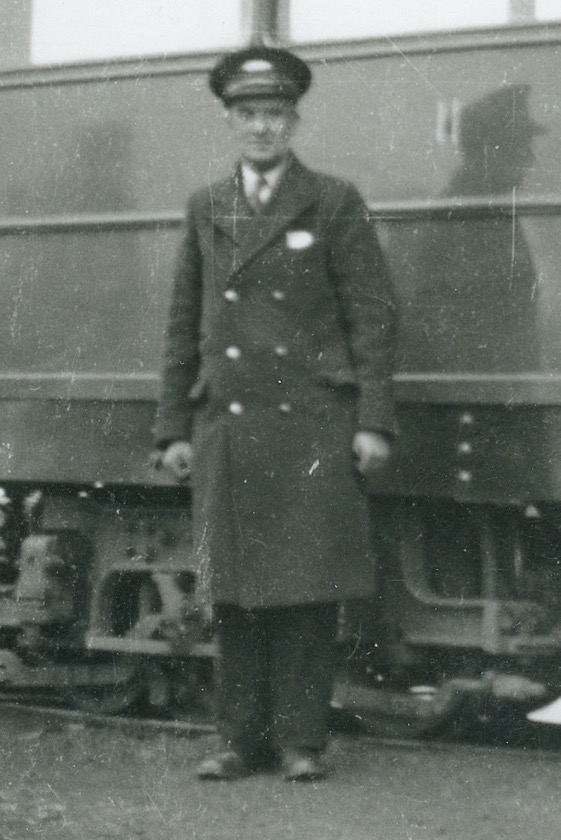
An enlargement of the above photograph showing the motorman. Although not sharp, it clearly shows that he is wearing an unmarked greatcoat and a cap bearing a BR Eastern Region 'totem' cap badge, which would almost certainly have been of the 'BRITISH RAILWAYS' variety.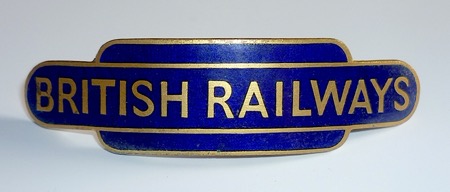
BR Eastern Region 'BRITISH RAILWAYS' cap badge — brass inlaid with Oxford Blue enamel. Author's Collection.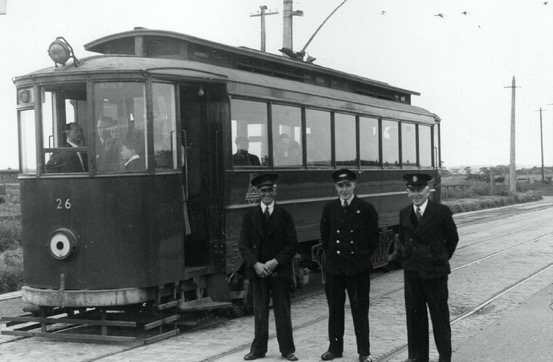
A motorman, a conductor and an inspector pose with Tramcar No 26 at Immingham Town on what is believed to be the 21st June 1953. Photo courtesy of the Jill Smith Collection.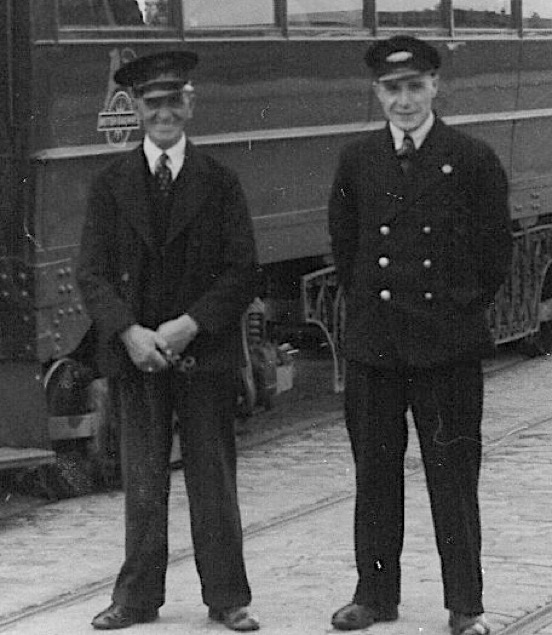
An enlargement of the above photograph showing the motorman and the conductor; the former appears to be wearing a cap with a tensioned crown but no cap badge, whereas the latter is clearly wearing a soft-topped cap with a 'totem' cap badge.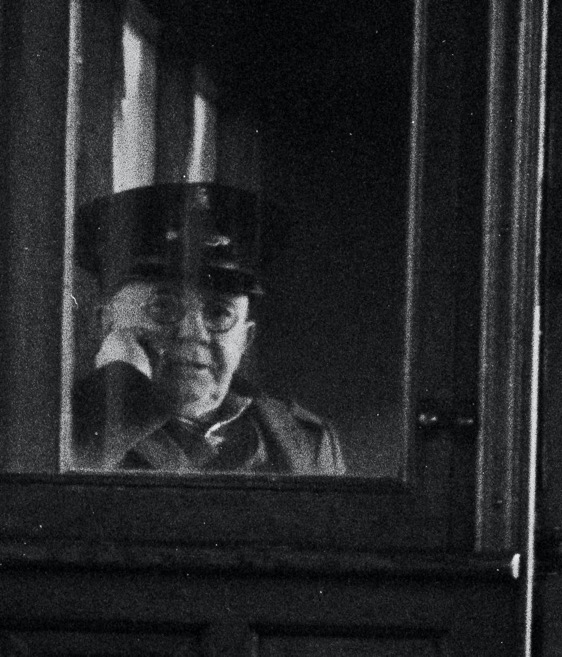
A tramcar crewman captured in the interior of Tramcar No 3 at Pyewipe Depot on the 12th November 1955. His lower badge appears to be a 'totem-style' cap badge, but with another badge above. Although it is difficult to be certain, this would appear to be the new style of British Railways cap badge (a demi-lion holding a wheel, emerging from a crown), which was introduced around this time. Photo courtesy of the National Tramway Museum. 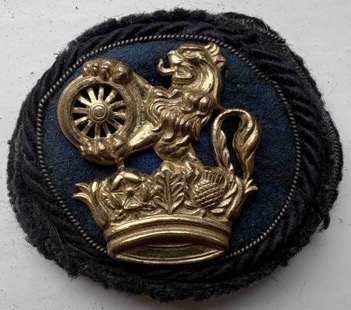
A British Railways cap badge comprising a demi-lion holding a wheel, emerging from a crown, mounted on what is probably an 'all-region' background — gilt. Currently, it is unclear whether this badge was worn with or without a cloth background, as definitive photos of the badge in use are yet to come to light. Author's Collection.
Senior staff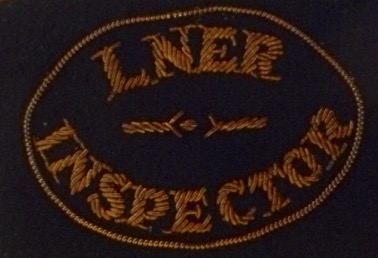
LNER inspector's badge — yellow embroidery on dark blue cloth. Tramcar inspectors may possibly have worn this badge at some stage, though confirmatory photographic evidence is currently lacking. Author's Collection.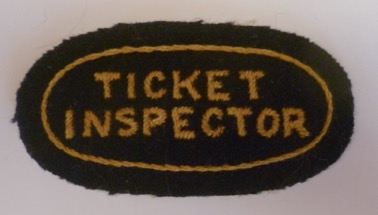
LNER ticket inspector's badge — yellow embroidery on dark blue cloth. Tramcar inspectors may possibly have worn this badge at some stage, though confirmatory photographic evidence is currently lacking. Author's Collection.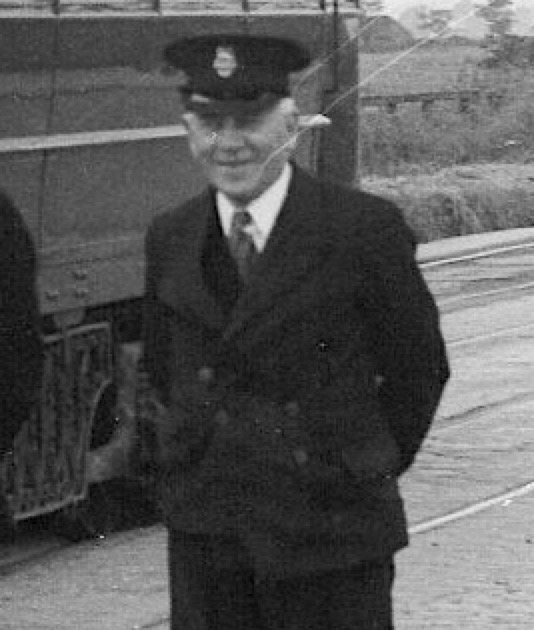
An enlargement of the 1953 photograph above showing the inspector. His cap bears one of the 'Lion over Wheel' badges introduced in 1950; the badge would have been gilt with a bar containing the grade — presumably either 'INSPECTOR' or the more general 'BRITISH RAILWAYS' — inlaid with BR(E) Oxford Blue enamel.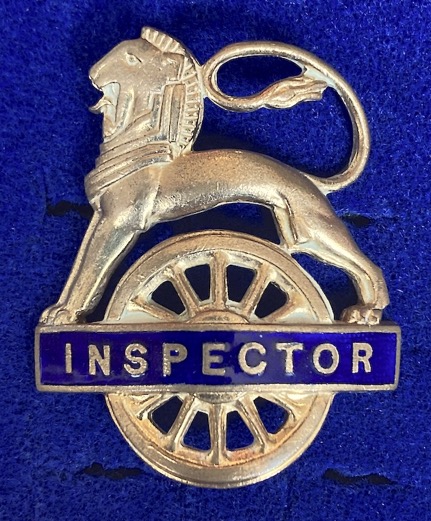
British Railways (Eastern Region) 'Lion over Wheel' inspector's cap badge — brass inlaid with Oxford Blue enamel. This type of badge was worn by senior staff between 1950 and 1956. Author's Collection.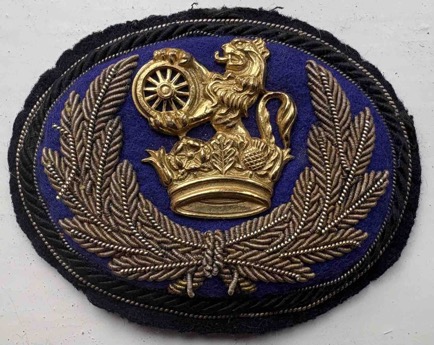
British Railways (Eastern Region) senior staff cap badge comprising a gilt demi-lion holding a wheel, emerging from a crown, surrounded by gold wire oak leaves, all mounted on an oval, dark-blue cloth background. This type of badge was possibly worn by senior staff between 1956 and closure. Author's Collection.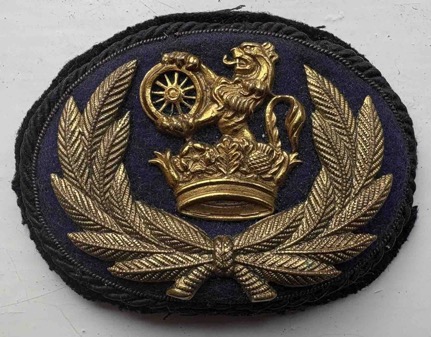
British Railways (Eastern Region) senior staff cap badge comprising a gilt demi-lion holding a wheel, emerging from a crown, surrounded by one-piece gilt metal oak leaves, all mounted on an oval, dark-blue cloth background. This type of badge was potentially worn by senior staff just prior to closure. Author's Collection.
Female staff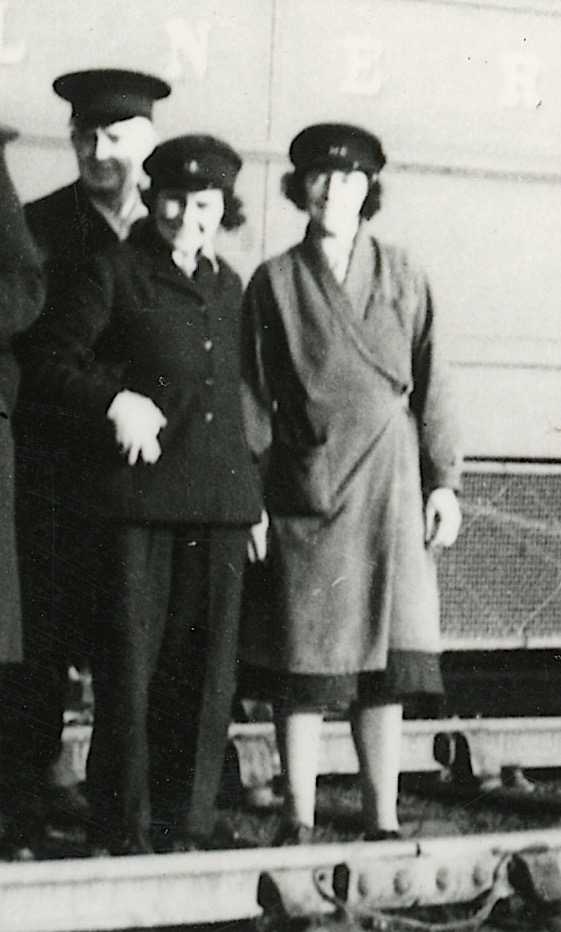
Another blow-up of the 1946 staff photograph above, this time showing two of the ladies. The lady on the right is wearing a wrap-around dustcoat and a soft-topped cap bearing 'N E' block initials, whilst the lady on the left, probably a conductress, is wearing a single-breasted jacket with lapels, along with a soft-topped cap bearing a cap badge, which cannot unfortunately be identified.